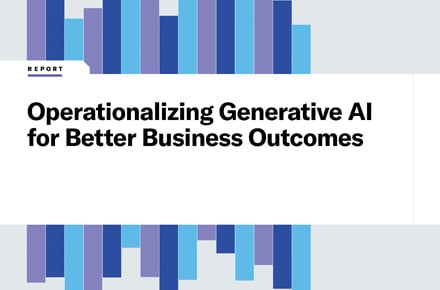OCM for AI: The who, why and how of employee adoption
September 14, 2023 / Kristine Krueger
Short on time? Read the key takeaways
- The era of artificial intelligence (AI) offers tremendous promise to benefit organizations. However, 11% of organizations are still in the discovery phase, and only 15% have integrated AI into their business DNA.
- While introducing new technology can cause frustration as employees must embark on continuous learning, AI tools can spark additional fears of job security overall: Will AI replace me? This adds a more profound challenge to adoption.
- Taking time to figure out the who, why and how of AI tool introduction can make the difference between user adoption success and stagnation.
Around the world, consumers and organizations alike are abuzz with the thrilling potential of artificial intelligence (AI) tools like ChatGPT. These tools offer incredible opportunities for organizations but also present unique user adoption challenges.
Introducing any new technology can result in hesitant or even anxious employees. In fact, I recently had a conversation with Weston Morris, senior director, global strategy for Digital Workplace Solutions at Unisys during a Deep Dive podcast episode about user adoption strategies. Knowing they’ll need to do their work differently can result in a few employee reactions: “Will I be able to learn the technology?” “Can I succeed at using it?” “Could I lose my job if I can’t adapt?”
When organizations introduce new technology, such as AI tools, they face unique challenges with user adoption. As we previously explored in “Fear and AI: Debunking the Myths that May Be Blocking Your Business,” one myth is that AI will eliminate the need for knowledge workers. Understandably, this fear can slow employee adoption and add an extra challenge for OCM practitioners.
But embracing AI can go a long way toward alleviating these worries. At the 2023 World Economic Forum’s Growth Summit, economist Richard Baldwin, a professor at the Geneva Graduate Institute in Switzerland, said something remarkable: “AI won't take your job. It's somebody using AI that will take your job."
Here’s the who, why and how of boosting user adoption of new AI technologies in your organization. Let’s start with the most important piece of any adoption puzzle – your people.
Who: Involve both early adopters and the apprehensive
In the blog post “5 data-driven strategies for OCM: A Microsoft Teams migration success story,” we explored strategies for boosting user adoption. Some of those strategies included early adoption by leaders and a champions program involving employees from across the organization. When implementing programs for AI adoption, consider who within the organization is most likely to benefit from AI tools and encourage them to get involved early on.
Support employee adoption further by developing programs that recognize and reward early AI adopters. This includes employees exploring the use of AI within the bounds of acceptable use – as well as those who originally embraced the technology before guidelines were in place. The latter can offer perspectives on using the tools in ways you might not have considered.
The “who” of the equation also includes employees at the other end of the adoption spectrum – those who could benefit from AI but are extremely reluctant to adopt these tools.
Reassure your employees that AI involves a collaboration rather than a replacement of workers. People are essential in overseeing the ethical use of AI tools. Human-in-the-loop, which involves human interaction with technology, is one way to adopt AI responsibly.
Understanding these reluctant adopters can be illuminating, revealing roadblocks to adoption that you need to address. Often, they become the biggest champions because they’ve been heard.
Why: AI as a key to employee innovation
Before introducing AI tools, determine the why – your organization’s motivation behind the technology adoption. If you don’t first define your corporate approach or philosophy to AI, your employees will likely be hesitant to use it, and you won’t achieve your desired outcomes from introducing AI. You’ll get scattershot adoption and won’t realize AI’s full business value.
In our 2023 Cloud Insights research, only 15% of organizations told us they’re integrating AI into their business DNA today, yet there is no shortage of ideas about how to use it. The top four use cases for AI are conversational AI (39%), predictive analytics (37%), augmented reality/virtual reality (34%) and computer vision (32%). These findings show that organizations prioritize using AI to improve operations and customer experiences.
Clarifying your organization’s specific motivation and how you hope to use AI within your business can set the direction from the beginning. If you don’t properly equip your leaders with the messaging to support that direction, you’ll be swimming upstream with user adoption.
How: Set up guardrails – for freedom rather than restriction
To encourage AI user adoption, you’ll need guardrails. The first one is the corporate philosophy or vision of AI’s future and how it can benefit the organization. Other guardrails include a list of approved AI tools for use in the workplace as well as written policies for how these tools are allowed to be used, including any restrictions.
Rather than restricting innovation, guardrails make room for it. For example, in one research study, researchers studied a park with swings, teeter-totters and other play structures in the middle of a park. It had no fence and was surrounded by roads, so children limited their play to the center and didn’t venture to the sides.
After a fence was built around the outside edge of the park, the researchers returned and noticed how the children began exploring farther out and creating imaginative games requiring no play structures.
In much the same way, introducing AI tools without setting guardrails will limit employees’ creativity in how they use these tools. Nervousness about the risk of overstepping unnamed boundaries will probably stifle the creativity of most employees - while at the other end of the spectrum, some employees will use the tools in ways you’d prefer they not. Guidelines free employees to explore how AI can be used within the organization to the edges of innovation.
For instance, guardrails could take into account network bandwidth limitations and security restrictions while also covering things like:
- What best practices to use for maximizing the benefits from AI tools
- Which generative AI-created content, if any, requires fact-checking
- Whether AI tools are used just internally or externally too
- How, or if, you let clients or partners know that a piece of content has been generated with AI assistance
Another way organizations can encourage user adoption is giving employees time. Time to train on the AI tools. Time to try performing different actions using the tools. Time to adapt their emotions and workflows to a new environment. This shows them how serious you are about them learning the tool and your willingness to invest in them so they can. If you don’t give them this time, they will simply say, “I don’t have time” when asked to adopt them.
Encourage user adoption of AI tools
Boost user adoption of AI tools across the organization by spending time on the who, why and how. Allocating sufficient time for employees to train on and get comfortable with AI tools, setting up guardrails for how employees use AI, and enlisting employees at all levels of AI excitement can go a long way in your efforts.
If you’d like support with introducing AI tools – or any other technology – explore how Unisys’ OCM solution can help.



















